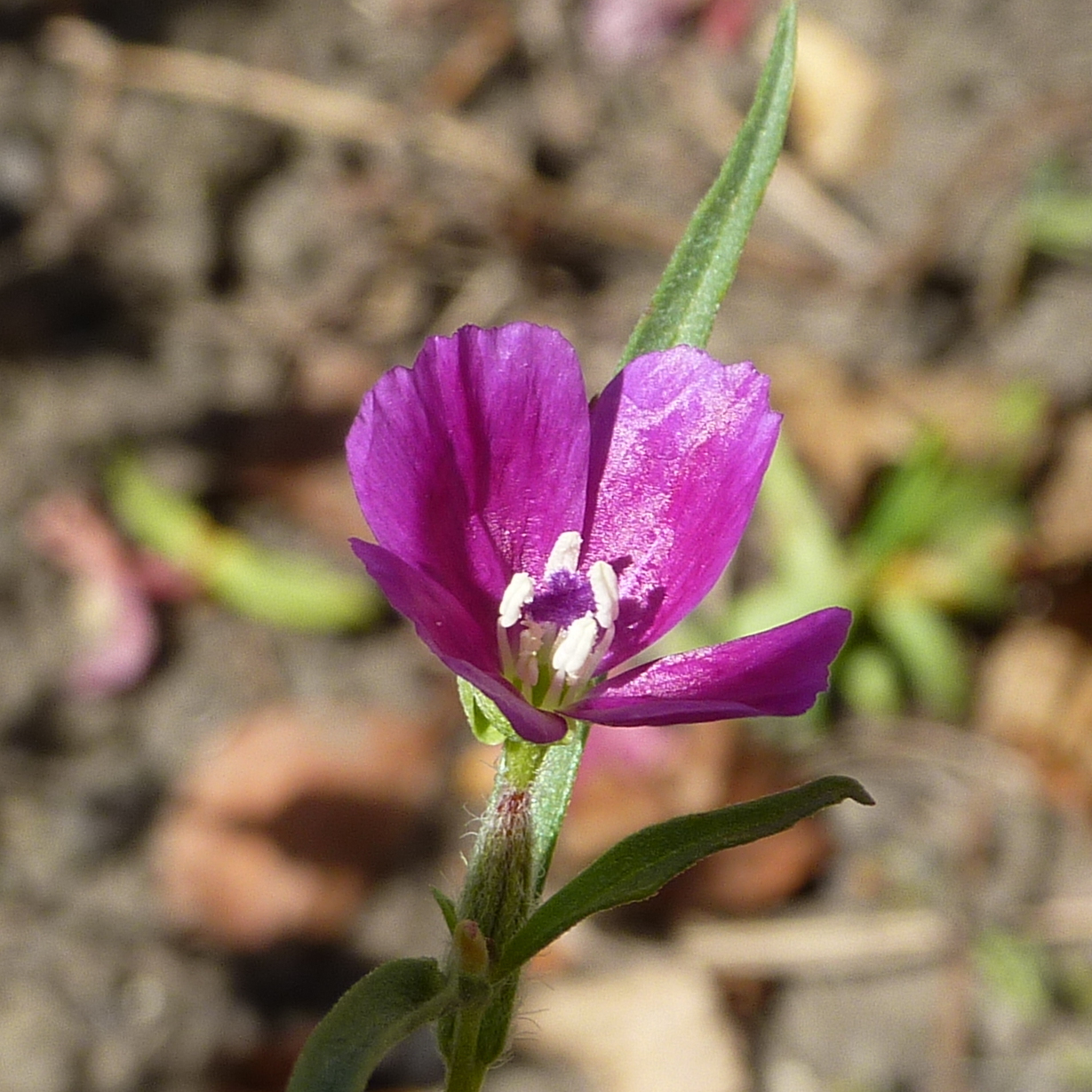Exploring Winecup Clarkia, Purple Clarkia
Scientifically recognized as Clarkia purpurea and classified under Onagraceae (Evening Primrose family), stands out as a distinctive Annual herb known for its unique characteristics. While it may also be found under other Synonyms, Clarkia elegans, Clarkia pulchella.withAlba’, ‘Dwarf Winecup form. You can use our free plant care app PlantPlants to identify Winecup Clarkia, Purple Clarkia.
Temperature
Can tolerate occasional frost; prefers moderate temperatures
Watering
Moderate; tolerate dry spells once established
Fertilizing
Balanced, slow-release fertilizer
Sunlight
Full sun to partial shade
Toxicity
Generally non-toxic, though not commonly consumed



Appearance and Growth Of Winecup Clarkia, Purple Clarkia
At maturity, this species reaches approximately 1 to 2 feet tall, presenting Lanceolate, alternate leaves, often with a slightly hairy texture along with Showy cup-shaped flowers, usually pink or purple with four petals, blooming from late spring to summer, followed by Elongated, thin capsules that split open when mature to release seeds. These features are supported by a reliable Fibrous root system, ensuring stability and sustained growth.
Winecup Clarkia, Purple Clarkia Origin and Habitat
Native to Native to western North America, especially California, Winecup Clarkia, Purple Clarkia thrives in Dry slopes, open grasslands, and disturbed areas at elevations around 0 to 6000 feet. Best suited for USDA Hardiness Zone 5 to 9. Whether grown indoor, in a curated garden or a more natural setting, its ecological requirements help maintain its vigor over time.



How to take Care of Winecup Clarkia, Purple Clarkia
Light, Soil and Watering Winecup Clarkia, Purple Clarkia.
You can use our free plant identify app PlantPlants to chose the best spot for Winecup Clarkia, Purple Clarkia, This plant prefers Full sun to partial shade and flourishes in Well-drained sandy or loamy soil with a soil pH of about 6.0 to 7.5.
Winecup Clarkia, Purple Clarkia needs watering,Moderate; tolerate dry spells once established, guided by PlantPlants app, You can get plants daily watering schedule. to maintain Low to moderate moisture, ensure steady hydration. Applying water through Drip irrigation or soaker hoses preferred supports even distribution and helps prevent overwatering or dryness.
Temperature and Humidity
Winecup Clarkia, Purple Clarkia performs best within 20 F to 100 F. Its ideal growth occurs at around 70 F to 85 F, though it tolerates ranges from Can tolerate occasional frost; prefers moderate temperatures. Additionally, maintaining Low to moderate humidity encourages healthy foliage and overall plant vigor.
Fertilization & Soil Health
Feeding with Balanced, slow-release fertilizer at the recommended Seasonal Application Frequency on PlantPlants App keeps nutrients balanced. Incorporating Compost or aged manure can be added enhances soil structure and fertility, while staying alert to Yellowing leaves, reduced growth rate helps you adjust care as needed to maintain optimal plant health.
Routine and Maintenance
Regular attention ensures this plant’s beauty and longevity. After flowering in late summer for Cut back spent flowers to encourage re-blooming tidies its appearance, while Not typically necessary; prefers to remain in the ground may be necessary as it grows, requiring a Use a pot 1-2 inches larger if potted increase and a fresh 50% potting soil, 30% sand, 20% compost. for Staking or Support. Generally does not need support but can be staked in windy conditions.
Seasonal Changes and Propagation of Winecup Clarkia, Purple Clarkia
During None; actively grows throughout spring and summer, growth may slow and some Leaves may die back after flowering can occur. For those looking to propagate, consider Seed propagation; cuttings can be taken but are less common and provide Germinate at room temperature with consistent moisture when starting from seed. If using cuttings, follow Use stem cuttings in early summer, provide warmth and humidity until roots develop to ensure successful rooting and healthy new plants.
Pests, Diseases and Prevention
our free plant identify and care app PlantPlants can help you diagnosisWinecup Clarkia, Purple Clarkia problems.Though generally robust, keep watch for Aphids, spider mites, and thrips and remain vigilant against Powdery mildew, root rot. Implementing Good air circulation and avoiding overhead watering and applying Insecticidal soap for pests; fungicides for diseases when issues arise will help sustain the plant thriving.
Companions and Uses of Winecup Clarkia, Purple Clarkia
This plant pairs nicely with California poppies, yarrow, and lupines and shows None noted, making it a flexible choice for various Borders, wildflower gardens, and xeriscaping.
Edible and Cultural Aspects
the Edible Parts: Young leaves and immature seed pods can be edible when cooked. Toxicty of Winecup Clarkia, Purple Clarkia, Generally non-toxic, though not commonly consumed. learning about its Harvest in late spring and early summer, Leaves can be used in salads, seed pods can be flavored or pickled, and Not well documented but likely contains vitamins and minerals typical of green leafy vegetables can be intriguing for culinary explorers. Some traditions highlight its Some traditional uses for mild skin irritations or note its Valued in native California cultures for its beauty and attractiveness to pollinators.
Conservation and Status
With an Not evaluated, proper Habitat preservation, especially in coastal and grassland regions
Frequently Asked Questions
1. What is Winecup Clarkia?
Winecup Clarkia is an annual flowering plant known for its beautiful cup-shaped flowers that bloom in various shades of pink and purple.
2. Where is Winecup Clarkia native to?
It is native to western North America, particularly California.
3. How do I care for Winecup Clarkia?
Provide full sun, well-drained soil, and moderate watering once established.
4. When does Winecup Clarkia bloom?
It typically blooms from late spring to summer.
5. Are the leaves of Winecup Clarkia edible?
Yes, young leaves can be consumed when cooked.
6. What pests might affect Winecup Clarkia?
Common pests include aphids and spider mites.
7. Can Winecup Clarkia tolerate drought?
Yes, once established, it can tolerate dry spells.
8. Should I fertilize Winecup Clarkia?
Yes, use a balanced fertilizer every 4-6 weeks during the growing season.
9. Is Winecup Clarkia toxic?
It is generally considered non-toxic.
10. How can I propagate Winecup Clarkia?
You can propagate via seeds or, less commonly, stem cuttings.




